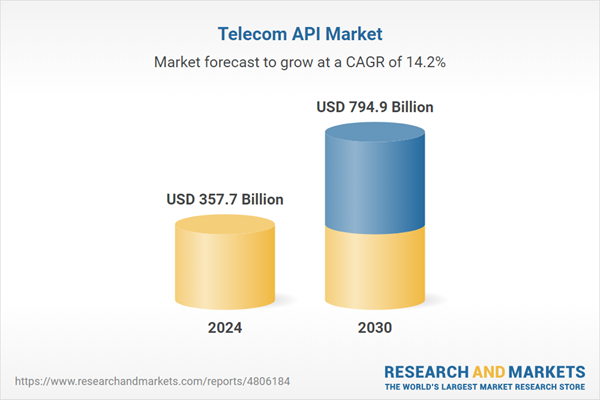The global market for Telecom API was valued at US$357.7 Billion in 2024 and is projected to reach US$794.9 Billion by 2030, growing at a CAGR of 14.2% from 2024 to 2030. This comprehensive report provides an in-depth analysis of market trends, drivers, and forecasts, helping you make informed business decisions. The report includes the most recent global tariff developments and how they impact the Telecom API market.
Advancements in telecom API technology have significantly expanded their scope and utility. The shift towards cloud-based API platforms has enabled scalable and flexible deployment, reducing the need for extensive infrastructure investment. Enhanced security features, such as end-to-end encryption and robust authentication mechanisms, have made telecom APIs reliable for handling sensitive data and communications. Additionally, the integration of artificial intelligence and machine learning algorithms into telecom APIs has improved their functionality, enabling more sophisticated services like chatbots, automated customer support, and predictive analytics. The rise of 5G technology is also expected to revolutionize telecom APIs, offering ultra-low latency and high bandwidth that will facilitate more advanced applications such as IoT (Internet of Things) connectivity, augmented reality, and real-time video streaming.
The growth in the telecom API market is driven by several factors. The increasing demand for enhanced communication services in various industries has spurred the adoption of telecom APIs, as businesses seek to offer more interactive and responsive customer experiences. The proliferation of mobile applications and the need for seamless integration of communication features have also contributed to market expansion. Technological advancements, particularly the deployment of 5G networks, are expected to provide a significant boost to the market by enabling faster and more reliable API interactions. Furthermore, the trend towards digital transformation and the increasing reliance on cloud-based services have accelerated the adoption of telecom APIs, as they offer a flexible and scalable solution for integrating communication capabilities. The growing emphasis on automation and the use of AI in customer service and business operations have further driven the demand for sophisticated telecom API solutions. Lastly, strategic collaborations and partnerships between telecom providers and technology companies are fostering innovation and expanding the reach of telecom APIs across different sectors.
Segments: API Type (SMS, MMS & RCS API, IVR/Voice Store & Voice Control API, Payment API, WebRTC API, ID/SSO & Subscriber API, Location API, Other API Types); Developer Type (Enterprise Developer, Partner Developer, Internal Developer, Long Tail Developer).
Geographic Regions/Countries: World; USA; Canada; Japan; China; Europe; France; Germany; Italy; UK; Spain; Russia; Rest of Europe; Asia-Pacific; Australia; India; South Korea; Rest of Asia-Pacific; Latin America; Argentina; Brazil; Mexico; Rest of Latin America; Middle East; Iran; Israel; Saudi Arabia; UAE; Rest of Middle East; Africa.
The analysts continuously track trade developments worldwide, drawing insights from leading global economists and over 200 industry and policy institutions, including think tanks, trade organizations, and national economic advisory bodies. This intelligence is integrated into forecasting models to provide timely, data-driven analysis of emerging risks and opportunities.
Global Telecom API Market - Key Trends & Drivers Summarized
Telecom APIs (Application Programming Interfaces) have become pivotal in the telecommunications industry, enabling developers to integrate advanced communication functionalities into their applications and services. These APIs allow applications to interact with telecom networks to perform a variety of functions such as sending SMS, making voice calls, managing data usage, and accessing user information securely. By offering these capabilities, telecom APIs facilitate the development of innovative solutions that enhance user engagement and streamline communication processes. They have opened up new opportunities for businesses across different sectors, including finance, healthcare, retail, and logistics, by allowing them to embed real-time communication features directly into their platforms.Advancements in telecom API technology have significantly expanded their scope and utility. The shift towards cloud-based API platforms has enabled scalable and flexible deployment, reducing the need for extensive infrastructure investment. Enhanced security features, such as end-to-end encryption and robust authentication mechanisms, have made telecom APIs reliable for handling sensitive data and communications. Additionally, the integration of artificial intelligence and machine learning algorithms into telecom APIs has improved their functionality, enabling more sophisticated services like chatbots, automated customer support, and predictive analytics. The rise of 5G technology is also expected to revolutionize telecom APIs, offering ultra-low latency and high bandwidth that will facilitate more advanced applications such as IoT (Internet of Things) connectivity, augmented reality, and real-time video streaming.
The growth in the telecom API market is driven by several factors. The increasing demand for enhanced communication services in various industries has spurred the adoption of telecom APIs, as businesses seek to offer more interactive and responsive customer experiences. The proliferation of mobile applications and the need for seamless integration of communication features have also contributed to market expansion. Technological advancements, particularly the deployment of 5G networks, are expected to provide a significant boost to the market by enabling faster and more reliable API interactions. Furthermore, the trend towards digital transformation and the increasing reliance on cloud-based services have accelerated the adoption of telecom APIs, as they offer a flexible and scalable solution for integrating communication capabilities. The growing emphasis on automation and the use of AI in customer service and business operations have further driven the demand for sophisticated telecom API solutions. Lastly, strategic collaborations and partnerships between telecom providers and technology companies are fostering innovation and expanding the reach of telecom APIs across different sectors.
Report Scope
The report analyzes the Telecom API market, presented in terms of units. The analysis covers the key segments and geographic regions outlined below.Segments: API Type (SMS, MMS & RCS API, IVR/Voice Store & Voice Control API, Payment API, WebRTC API, ID/SSO & Subscriber API, Location API, Other API Types); Developer Type (Enterprise Developer, Partner Developer, Internal Developer, Long Tail Developer).
Geographic Regions/Countries: World; USA; Canada; Japan; China; Europe; France; Germany; Italy; UK; Spain; Russia; Rest of Europe; Asia-Pacific; Australia; India; South Korea; Rest of Asia-Pacific; Latin America; Argentina; Brazil; Mexico; Rest of Latin America; Middle East; Iran; Israel; Saudi Arabia; UAE; Rest of Middle East; Africa.
Key Insights:
- Market Growth: Understand the significant growth trajectory of the SMS, MMS & RCS API segment, which is expected to reach US$283.5 Billion by 2030 with a CAGR of a 16.3%. The IVR/Voice Store & Voice Control API segment is also set to grow at 15.0% CAGR over the analysis period.
- Regional Analysis: Gain insights into the U.S. market, valued at $96.3 Billion in 2024, and China, forecasted to grow at an impressive 19.4% CAGR to reach $181.2 Billion by 2030. Discover growth trends in other key regions, including Japan, Canada, Germany, and the Asia-Pacific.
Why You Should Buy This Report:
- Detailed Market Analysis: Access a thorough analysis of the Global Telecom API Market, covering all major geographic regions and market segments.
- Competitive Insights: Get an overview of the competitive landscape, including the market presence of major players across different geographies.
- Future Trends and Drivers: Understand the key trends and drivers shaping the future of the Global Telecom API Market.
- Actionable Insights: Benefit from actionable insights that can help you identify new revenue opportunities and make strategic business decisions.
Key Questions Answered:
- How is the Global Telecom API Market expected to evolve by 2030?
- What are the main drivers and restraints affecting the market?
- Which market segments will grow the most over the forecast period?
- How will market shares for different regions and segments change by 2030?
- Who are the leading players in the market, and what are their prospects?
Report Features:
- Comprehensive Market Data: Independent analysis of annual sales and market forecasts in US$ Million from 2024 to 2030.
- In-Depth Regional Analysis: Detailed insights into key markets, including the U.S., China, Japan, Canada, Europe, Asia-Pacific, Latin America, Middle East, and Africa.
- Company Profiles: Coverage of players such as Apple, Inc., AT&T, Inc., Avaya, Inc., AMDOCS, China Mobile Ltd. and more.
- Complimentary Updates: Receive free report updates for one year to keep you informed of the latest market developments.
Some of the 130 companies featured in this Telecom API market report include:
- Apple, Inc.
- AT&T, Inc.
- Avaya, Inc.
- AMDOCS
- China Mobile Ltd.
- Aspect Software, Inc.
- 2600hz, Inc.
- BICS SA/NV
- Cafex Communications, Inc.
- ALE International
- Apizee
- BrainCert
- Bistri
- Bit6
- Ceeblue Media Services
Tariff Impact Analysis: Key Insights for 2025
Global tariff negotiations across 180+ countries are reshaping supply chains, costs, and competitiveness. This report reflects the latest developments as of April 2025 and incorporates forward-looking insights into the market outlook.The analysts continuously track trade developments worldwide, drawing insights from leading global economists and over 200 industry and policy institutions, including think tanks, trade organizations, and national economic advisory bodies. This intelligence is integrated into forecasting models to provide timely, data-driven analysis of emerging risks and opportunities.
What’s Included in This Edition:
- Tariff-adjusted market forecasts by region and segment
- Analysis of cost and supply chain implications by sourcing and trade exposure
- Strategic insights into geographic shifts
Buyers receive a free July 2025 update with:
- Finalized tariff impacts and new trade agreement effects
- Updated projections reflecting global sourcing and cost shifts
- Expanded country-specific coverage across the industry
Table of Contents
I. METHODOLOGYMII. EXECUTIVE SUMMARY2. FOCUS ON SELECT PLAYERSIII. MARKET ANALYSISCANADAFRANCEGERMANYITALYUNITED KINGDOMSPAINRUSSIAREST OF EUROPEAUSTRALIAINDIASOUTH KOREAREST OF ASIA-PACIFICARGENTINABRAZILMEXICOREST OF LATIN AMERICAIRANISRAELSAUDI ARABIAUNITED ARAB EMIRATESREST OF MIDDLE EASTIV. COMPETITION
1. MARKET OVERVIEW
3. MARKET TRENDS & DRIVERS
4. GLOBAL MARKET PERSPECTIVE
UNITED STATES
JAPAN
CHINA
EUROPE
ASIA-PACIFIC
LATIN AMERICA
MIDDLE EAST
AFRICA
Companies Mentioned (Partial List)
A selection of companies mentioned in this report includes, but is not limited to:
- Apple, Inc.
- AT&T, Inc.
- Avaya, Inc.
- AMDOCS
- China Mobile Ltd.
- Aspect Software, Inc.
- 2600hz, Inc.
- BICS SA/NV
- Cafex Communications, Inc.
- ALE International
- Apizee
- BrainCert
- Bistri
- Bit6
- Ceeblue Media Services
Table Information
| Report Attribute | Details |
|---|---|
| No. of Pages | 553 |
| Published | April 2025 |
| Forecast Period | 2024 - 2030 |
| Estimated Market Value ( USD | $ 357.7 Billion |
| Forecasted Market Value ( USD | $ 794.9 Billion |
| Compound Annual Growth Rate | 14.2% |
| Regions Covered | Global |









